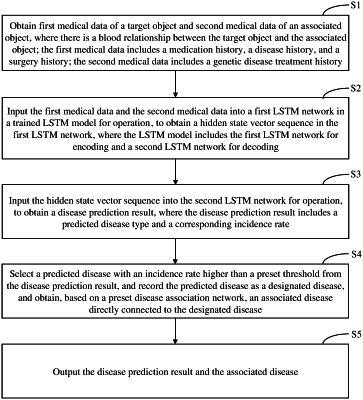| CPC G16H 50/50 (2018.01) [G06N 3/045 (2023.01); G06N 3/0442 (2023.01); G16H 50/20 (2018.01); G16H 50/30 (2018.01)] | 20 Claims |

|
1. A long short-term memory (LSTM) model-based disease prediction method, comprising:
obtaining first medical data of a target object and second medical data of an associated object, wherein there is a blood relationship between the target object and the associated object; the first medical data comprises a medication history, a disease history, and a surgery history; the second medical data comprises a genetic disease treatment history;
inputting the first medical data and the second medical data into a first LSTM network in a trained LSTM model for operation, to obtain a hidden state vector sequence in the first LSTM network, wherein the LSTM model comprises the first LSTM network for encoding and a second LSTM network for decoding;
inputting the hidden state vector sequence into the second LSTM network for operation, to obtain a disease prediction result, wherein the disease prediction result comprises a predicted disease type and a corresponding incidence rate;
selecting a predicted disease with an incidence rate higher than a preset threshold from the disease prediction result, and recording the predicted disease as a designated disease, and obtaining, based on a preset disease association network, an associated disease directly connected to the designated disease, wherein network nodes of the association network are different types of diseases; and
outputting the disease prediction result and the associated disease.
|